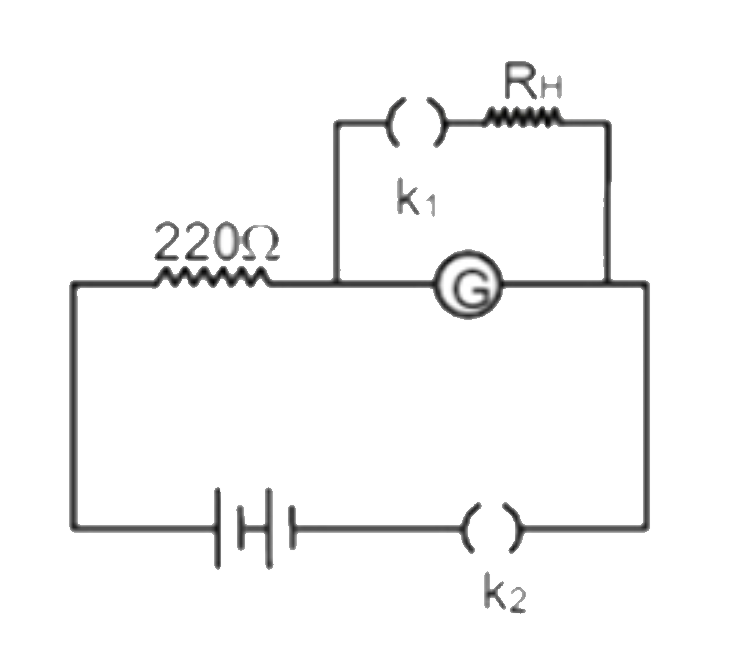Conversion of Galvanometer
To convert a galvanometer into an ammeter, we need to follow a systematic approach. Here’s a step-by-step solution:
Step 1: Understand the Function of a Galvanometer
A galvanometer is an instrument used to detect and measure small electric currents. It has a limited range and can only measure currents up to a certain value.
Hint: Remember that a galvanometer measures small currents and has a specific internal resistance.
Step 2: Determine the Full Scale Deflection (FSD) of the Galvanometer
Identify the full-scale deflection current (I_g) that the galvanometer can measure. This is the maximum current that can pass through the galvanometer without damaging it.
Hint: The FSD is usually provided in the specifications of the galvanometer.
Step 3: Choose the Desired Range for the Ammeter
Decide the maximum current (I) that you want the ammeter to measure. This value should be greater than the FSD of the galvanometer.
Hint: The desired range should be practical for the applications you intend to use the ammeter for.
Step 4: Calculate the Required Shunt Resistance
To convert the galvanometer into an ammeter, we need to connect a shunt resistor (R_s) in parallel with the galvanometer. The value of the shunt resistor can be calculated using the formula:
Rs=Rg⋅IgI−Ig
Where:
- Rg = internal resistance of the galvanometer
- Ig = full-scale deflection current of the galvanometer
- I = desired maximum current for the ammeter
Hint: The shunt resistor allows most of the current to bypass the galvanometer, protecting it from high currents.
Step 5: Connect the Shunt Resistor
Connect the calculated shunt resistor in parallel with the galvanometer. This configuration allows the galvanometer to measure the current flowing through it while the shunt resistor carries the excess current.
Hint: Ensure that the connections are secure to avoid any measurement errors.
Step 6: Test the Ammeter
Once the shunt resistor is connected, test the ammeter with known current values to ensure it is functioning correctly and providing accurate readings.
Hint: Calibration may be necessary to ensure the accuracy of the ammeter.
Summary
By following these steps, you can successfully convert a galvanometer into an ammeter by using a shunt resistor. This allows you to measure larger currents safely.
A galvanometer is an instrument used to detect and measure small electric currents. It has a limited range and can only measure currents up to a certain value.
Identify the full-scale deflection current (I_g) that the galvanometer can measure. This is the maximum current that can pass through the galvanometer without damaging it.
Decide the maximum current (I) that you want the ammeter to measure. This value should be greater than the FSD of the galvanometer.
To convert the galvanometer into an ammeter, we need to connect a shunt resistor (R_s) in parallel with the galvanometer. The value of the shunt resistor can be calculated using the formula:
- Rg = internal resistance of the galvanometer
- Ig = full-scale deflection current of the galvanometer
- I = desired maximum current for the ammeter
Connect the calculated shunt resistor in parallel with the galvanometer. This configuration allows the galvanometer to measure the current flowing through it while the shunt resistor carries the excess current.
Once the shunt resistor is connected, test the ammeter with known current values to ensure it is functioning correctly and providing accurate readings.
By following these steps, you can successfully convert a galvanometer into an ammeter by using a shunt resistor. This allows you to measure larger currents safely.
Topper's Solved these Questions
Similar Questions
In tangent galvanometer generally for more accuracy deflection of galvanometer should be taken in range of
View SolutionSensitivity of moving coil galvanometer is 's'. If a shunt of (18)th of the resistance of galvanometer is connected to moving coil galvanometer, its sensitivity becomes
View Solution
Knowledge Check
The conversion of a moving coil galvanometer into a voltmeter is done by
Aintroducing a resistance of large value in seriesBintroducing a resistance of small value in parallelCintroducing a resistance of large value in parallelDintroducing a resistance of small value in series
In a ammeter 0.2% of main current passes through the galvanometer. If resistance of galvanometer is G, the resistance of ammeter will be
View SolutionAs shown in the figure initially switch k1 is open and k2 is closed and deflection of galvanometer is x. Now both switch are closed then the deflection in galvanometer is x/5 (given RH=5Ω). The resistance of galvanometer is

View SolutionDeflection of galvanometer in the circuit is 71 divisions. A shunt of 15Ω is connected parallel to galvanometer and value of R is adjusted such that main current ramains the same. If the deflection in the galvanometer falls to 15 divisions then the resistance G of galvanometer in (in ohm)

View SolutionThe deflection in a moving coil galvanometer is
View SolutionIn a moving coil galvanometer is based on the
View SolutionIn a moving coil galvanometer, we use a radial magnetic field so that the galvanometer scale is
View SolutionThe deflection in moving coil galvanometer is reduced to half when it is shunted with a 40Ω coil . The resistance of the galvanometer is
View Solution
